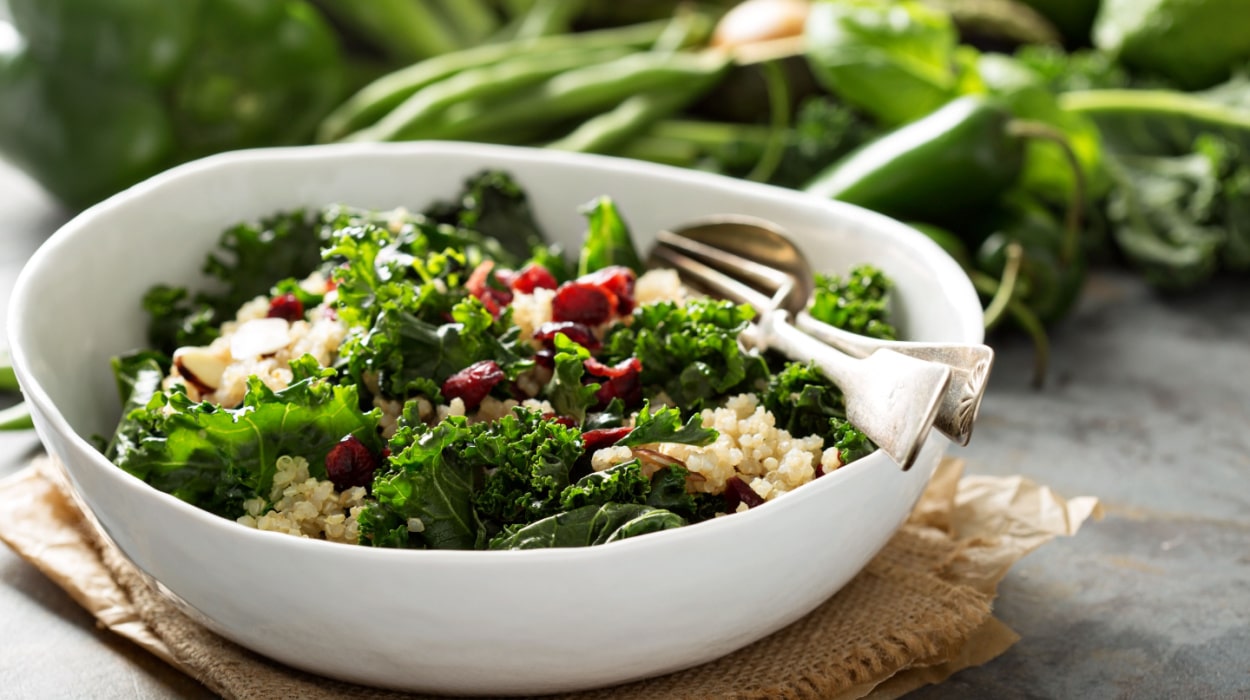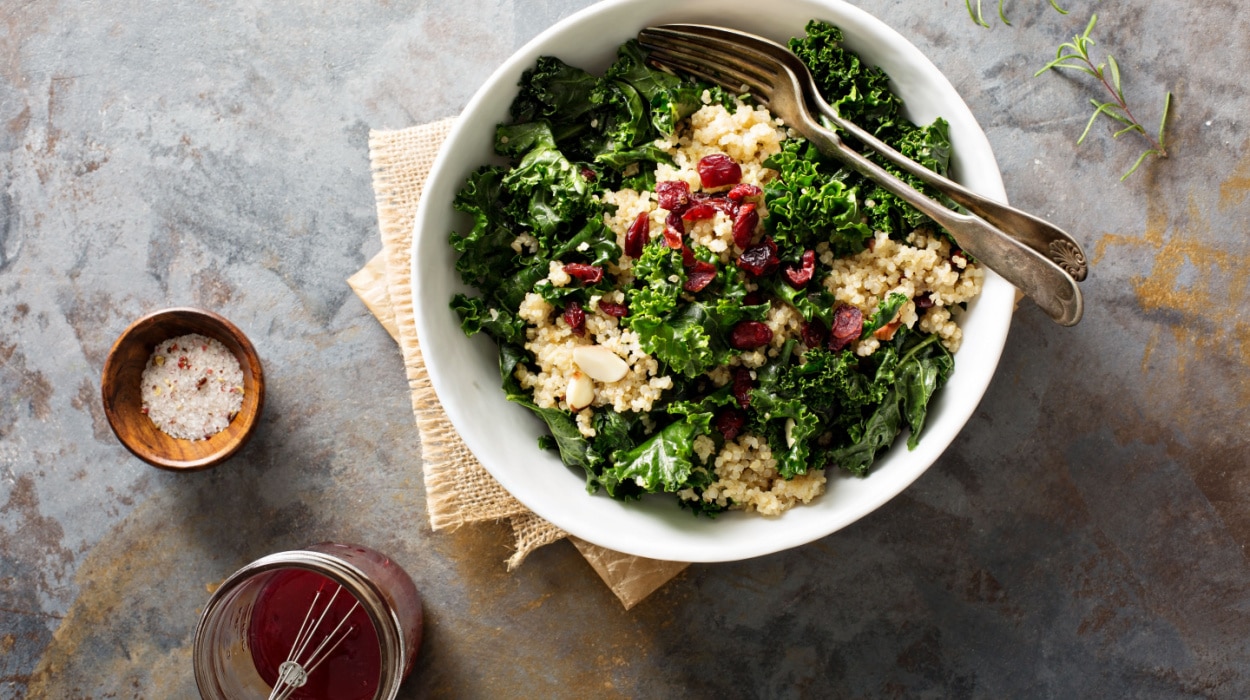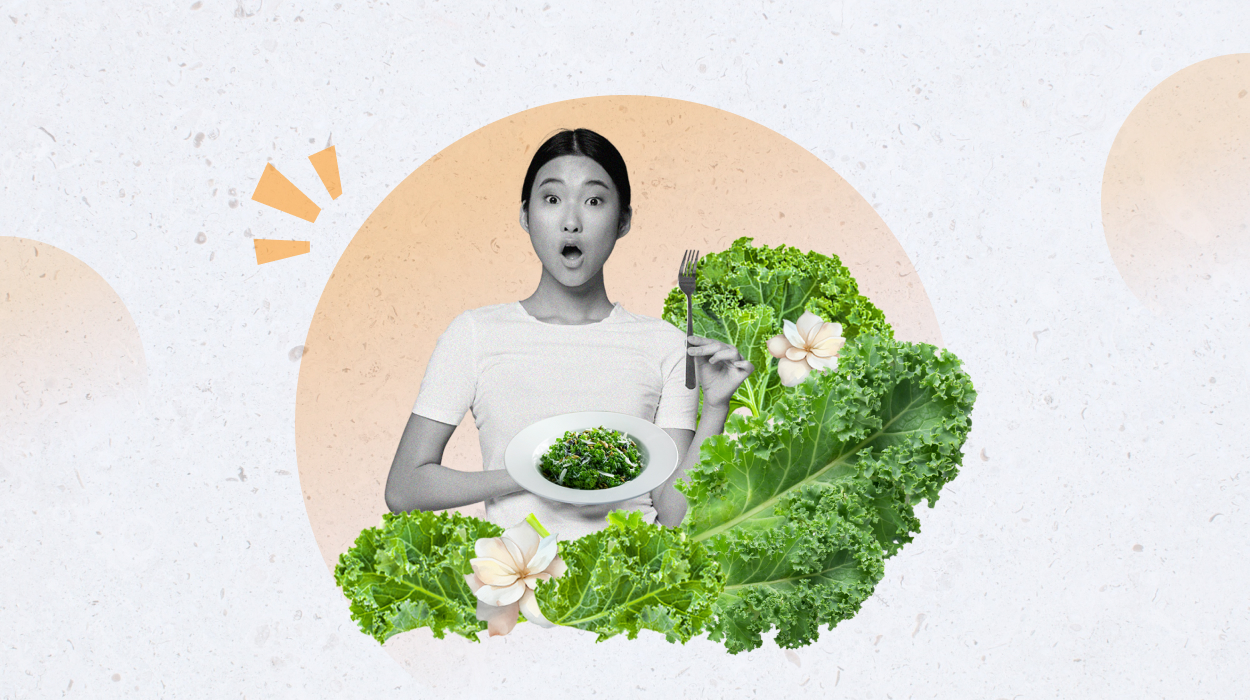Kale is one of the healthiest vegetables, not to mention the tastiest, you can add to your diet. Leafy greens have a reputation for being health boosters, but kale in particular is a powerhouse of nutrients. So much so, that it’s used in some of the best green powders. Among its many health benefits, can help improve mood, energy, and immunity and it’s a food that can help fight dementia. When considering the benefits of super green foods, look no further than kale. Let’s explore how to eat kale in this article.
How To Eat Kale?
- Sauteed kale
- Kale chips
- Kale smoothies
- Kale juices
- Kale salads
- Kale wraps
- Steamed kale
- Kale soups
- Kale as a garnish
- Kale dip
How To Eat Kale?
Sauteed Kale
Is there anything better than sauteed kale? Not likely. It’s delicious, healthy and so simple. Simply throw some washed kale in a pan or wok and add a cooking oil of your choice. You can throw in some garlic, onions, sesame oil, sunflower or pumpkin seeds, and any seasoning you like. You may also choose to saute kale with bacon bits and a little maple syrup.
Kale Chips
Crispy kale chips are one of the most delicious healthy snacks you can enjoy guilt-free, any time of the day. They’re also super simple to make. Preheat the oven to 275 degrees. Peel kale off the spine and cut into small pieces (1-2 inches). Lay the pieces on a baking sheet and drizzle with olive oil, salt, and any other seasoning you wish. Put in the oven and bake for about 20 minutes or until desired crispiness.
Kale Smoothies
For those who don’t particularly want to eat their baby kale, it’s so easy to enjoy in smoothies because it blends up nicely in a blender. You can choose your liquid base, such as coconut water or almond milk, add some fruit, veggies, maybe a scoop of avocado or nut butter, then throw in a handful of chopped kale. This may turn your smoothie green, but if you have enough sweet fruit in the smoothie, you’ll never taste the kale.
Kale Juices
All you need for this “recipe” is a juicer! Wash your kale, then run it through the juicer. This will give you a high and immediate dose of the vitamins and minerals in kale, however, juicing does strip the fiber away. Since fiber is essential to well-being, it’s important that if you drink kale juice, you’re drinking it in addition to eating vegetables, rather than instead.
Kale Salad
If you’re tired of the same boring salad with romaine lettuce, you’re in luck. Swap it out for kale, instead. Kale can be a wonderful leafy green base to any salad, no matter what other ingredients you add. You may even wish to do a mixture of kale and spinach, kale and lettuce, or kale and arugula. Whatever you can think of!
Kale Wraps
Many people need to avoid traditional wheat wraps, either because they can’t tolerate gluten, or are looking to cut back on processed carbs. Whatever the reason for not wanting to use traditional wraps, there’s an easy, healthy alternative – wrapping your food in a big leaf of kale! Slice up some fresh turkey, tomatoes, avocado, carrots, and cheese, and wrap it neatly in kale for a crunchier, healthier lunch wrap.
Steamed Kale
If you’re looking to soften your kale and avoid any cooking oils, steaming it is the way to go. Add some water to the base pot, then lay the steaming piece on top of it. Put the kale in the steamer, cover it with a lid, and let the steam from the water cook the kale. This is a great way to cook kale without adding any calories, or if you want to soften it enough for a toddler to eat.
Kale Soups
Making kale soups is similar to making kale smoothies, but instead of adding sweet ingredients, you add savory ones. And instead of serving it cold, you’d serve it warm. The other ingredients will be a matter of preference. For example, you may want to use potatoes, carrots, celery, garlic, onions, vegetable broth, and of course, kale! Saute or steam all the ingredients until soft, then add to a blender or food processor to make it smooth and creamy (or if you like chunky soup, skip the blending). Add vegetable broth for a more liquid consistency, then serve warm.
Kale As A Garnish
Though you won’t get any of the health benefits of kale just by looking at it, it’s worth noting that kale is very pretty to look at – pretty enough to be used as a garnish. If you’re not interested in eating large amounts of kale, you may add chopped kale in a small portion to decorate your plate, as a “blanket” for your main meal to sit on, or to add a pop of color to your dish.
Kale Dip
For a dip, you’ll want to choose a base such as black beans, chickpeas, or sugar-free Greek yogurt. Put the beans or yogurt in a blender and add a lot of kale! Add whatever seasoning you like (salt and pepper are pretty standard, but you may also want to add onions, cumin, basil, garlic, thyme, fresh lemon juice, olive oil, and rosemary). Blend until you get a smooth, creamy consistency. You can add water if it’s too thick, or add more kale or beans/yogurt to thicken it up.
Kale Nutritional Profile

Just how healthy is kale? It’s pretty high up there, which is why it’s considered a superfood. It’s nutrient-dense,[1] yet low in calories. Let’s look more closely at the nutritional breakdown of one cup of raw kale.
- 7 calories
- 0.6 grams of protein
- 0.9 grams of carbs
- 0.3 grams of fat
- 0.8 grams of fiber
- 0.2 grams of sugar
Vitamins And Minerals
- Vitamin A: 49.6mcg
- Vitamin K: 80.3mcg
- Vitamin C: 19.2mg
- Potassium: 71.7mg
- Calcium: 52.3mg
Benefits Of Eating Kale

Better Digestion
Kale is rich in fiber, an essential component of gut health. Fiber helps to clean out the gastrointestinal tract, which keeps bowel movements regular. This necessary function helps keep toxins out of the body. Additionally, the fiber in the kale feeds our beneficial gut bacteria,[2] our gut microbiome, which is responsible for not only our digestive health but also our mood, immunity, and longevity. In some cases, when you eat raw kale and feel difficult to digest, cooked kale may be an easier option.
Better Memory
If you’re looking to improve your cognitive health, including having better memory, try eating kale a few times daily. Research shows that eating kale is beneficial for brain health, may slow down brain aging, and may increase mental clarity and sharpness. Kale also has vitamins A, C, and K, antioxidants that further support cognition and brain function.
Better Energy
Among its many benefits, kale can provide sustained energy throughout the day. The fiber and nutrients in kale help to stabilize blood sugar, which is a cornerstone for lasting energy. Kale also contains the amino acid L-tyrosine which can help boost energy and increase focus.
Better Immunity
In addition to other antioxidants, kale is full of vitamin C,[3] a water-soluble vitamin that boosts immunity. Vitamin C’s role in keeping immune cells strong and healthy is incomparable to other nutrients, and kale has higher amounts of vitamin C than most other green leafy vegetables (about three times more than spinach and collard greens).
Lower Inflammation
Kale is part of an anti-inflammatory[4] diet. Just one cup of kale provided 10% of the daily recommended dose of omega-3 fatty acids, which fight inflammation. Many other compounds in kale, including its array of vitamins and minerals work to lower and manage inflammatory reactions in the body, leading to less disease.
Lower Cholesterol
Kale has properties that can help keep cholesterol in good standing. In the body, one of the liver’s jobs is to turn cholesterol into bile acids, which are stored for later when you eat a fatty meal (the bile acids are released to help digest fats). The leftover bile acids get reabsorbed in our bloodstream, however, kale contains compounds that can bind to bile acids, blocking them from being reabsorbed, which can then reduce our cholesterol levels. In studies, kale juice[5] was shown to improve cholesterol levels and heart health in general.
Can Help Fight Cancer
One way kale can help fight or protect against cancer is by boosting immunity. Additionally, kale has substances like indole-3-carbinol and sulforaphane which have the ability to block cancer cell formation[6] and growth. That’s why kale, among other cruciferous vegetables, is regularly prescribed as part of an anti-cancer diet.
Good For Weight Loss
Because kale is high in nutrients but low in calories, it’s an ideal food to include in your diet for weight loss. This fiber-packed vegetable creates satiety, and a feeling of fullness, leaving less room for hunger and snacking. Kale can be eaten in abundance without worry of weight gain. For those who still like to snack, eating kale chips (baked kale) can help satisfy those cravings.
How Much Kale Is Too Much?
Generally speaking, kale is a superfood that has positive effects on many aspects of health. That being said, you can always have too much of a good thing. The general consensus is that one or two servings per day is fine, but more than that can pose certain issues for some individuals. For example, kale is high in vitamin A which can be toxic if consumed in large amounts. Additionally, the compound progoitrin in kale may interfere with thyroid functions. Otherwise, it’s safe to eat every day, and best eaten with a source of healthy fat such as nuts, avocado, or olive oil (fat helps vitamins absorb better in the body).
Conclusion
Kale leaf, the super green superfood, is a great food to eat on a daily basis. Fresh kale adds some variety to your salads, sandwiches, and dinner plates. Kale is filled with fiber, antioxidants, and other nutrients that have immune-boosting brain-enhancing powers. Kale is safe to eat for most individuals and can be enjoyed as a snack, main dish, lettuce replacement, or in a juice or smoothie.
Frequently Asked Questions
Kale has a similar nutritional makeup as other leafy greens, but generally has more antioxidants. For example, it has about three times more vitamin C than spinach and collard greens.
Some of the antioxidants and other nutritional components of kale are lost during the cooking process. That being said, both raw and cooked kale have health benefits. If well-tolerated, it’s best to have a mixture of both raw and cooked kale in your diet.
You’ll get the most health benefits from kale by keeping the fiber intact, which means eating it whole without juicing it (juicing removes the fiber). Most cooking methods are healthful, however, when choosing a cooking method, avoid frying. Sautee, bake or steam it instead. For oil/seasoning, opt for anti-inflammatory oils such as coconut olive oil or grass-fed butter.
 Expert's opinion
Expert's opinion
